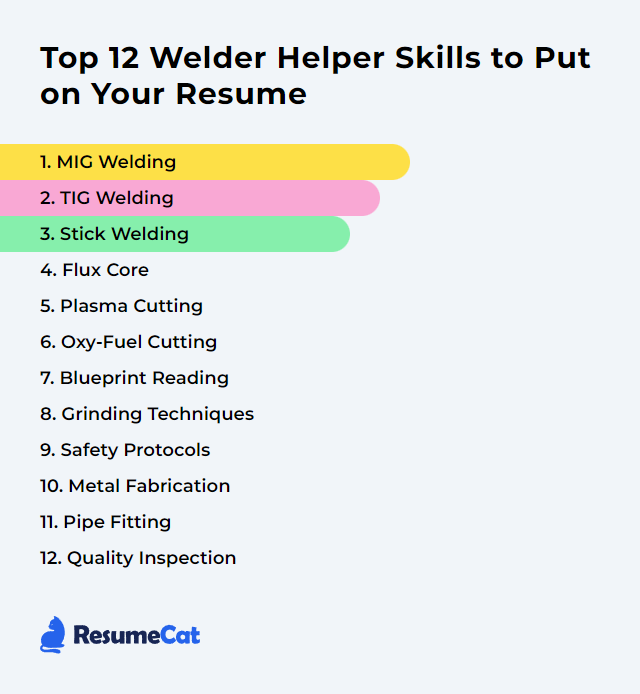Top 12 Welder Helper Skills to Put on Your Resume
In the dynamic and highly specialized field of welding, a sharp, well-shaped resume can give a welder helper real lift. Showcase the skills that prove you can support lead welders, keep work moving, and stay safe. That mix gets attention and opens doors in this hands-on trade.
Welder Helper Skills
- MIG Welding
- TIG Welding
- Stick Welding
- Flux Core
- Plasma Cutting
- Oxy-Fuel Cutting
- Blueprint Reading
- Grinding Techniques
- Safety Protocols
- Metal Fabrication
- Pipe Fitting
- Quality Inspection
1. MIG Welding
MIG welding (also called GMAW) uses a continuously fed wire electrode and shielding gas to join metals with speed and consistency. As a Welder Helper, you prep materials, set machines, manage consumables, and keep the station tidy and safe so the welder can focus on the bead.
Why It's Important
MIG welding delivers fast, clean, repeatable welds on a wide range of metals and thicknesses. It’s approachable, productive, and everywhere—from fabrication shops to field work—so competence here helps you contribute immediately and grow fast.
How to Improve MIG Welding Skills
Better MIG starts with clean prep and tight setup, then stacks on practice:
Dial in the machine: Match wire type and diameter to the job. Set wire feed speed and voltage for material thickness. Check drive-roll tension and contact tip size.
Hold a steady angle: Keep a 10–15° push or pull angle depending on the joint and position. Move at a pace that maintains a stable arc sound and consistent puddle.
Practice on scrap: Test settings and travel speed on offcuts before touching the workpiece.
Suit up: Proper helmet shade, gloves, jacket, and boots. Good PPE makes you calmer and your work cleaner.
Clean metal: Remove rust, paint, mill scale, and oil. Contamination ruins fusion and appearance.
Ask for feedback: Shadow experienced welders. Study bead profile, sound, and heat control.
Stack small wins. Repeat. Quality goes up, rework goes down.
How to Display MIG Welding Skills on Your Resume
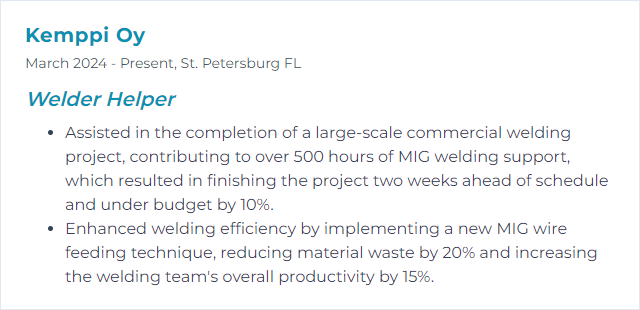
2. TIG Welding
TIG welding (GTAW) uses a non-consumable tungsten electrode and separate filler for precision control. Both hands are working, often with foot-pedal heat control. It shines on thin stock, stainless, aluminum, and jobs where appearance matters.
Why It's Important
It produces clean, strong welds with minimal spatter and excellent control over heat input—vital where distortion and finish quality are critical.
How to Improve TIG Welding Skills
Short, steady arc: Keep arc length tight to stabilize the puddle and reduce contamination.
Immaculate prep: Clean base metal and filler. Dedicated brushes for aluminum and stainless. Degrease thoroughly.
Right tungsten and grind: Choose tungsten type/size for the material and current. Grind lengthwise and keep tips consistent.
Synchronize torch and filler: Dip rhythmically at the leading edge of the puddle. Don’t stir the tungsten into the puddle.
Pedal finesse: Feather heat in and out. Modulate to control puddle size and penetration.
Shielding matters: Set gas flow correctly and use proper cup size and gas lens when needed.
Post-weld clean: Brush stainless and aluminum; remove oxidation to preserve corrosion resistance.
Precision comes with repetition. Go slow, then go smooth.
How to Display TIG Welding Skills on Your Resume
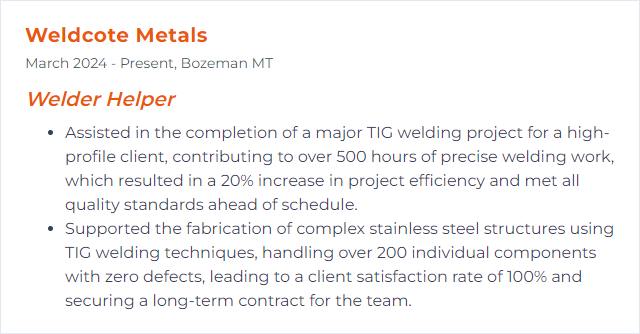
3. Stick Welding
Stick welding (SMAW) uses flux-coated electrodes to form the weld and shielding. It’s rugged, portable, and forgiving outdoors and in tight spots.
Why It's Important
It tackles dirty steel, windy weather, and awkward positions. Repairs, structural work, field jobs—SMAW earns its keep where other processes struggle.
How to Improve Stick Welding Skills
Surface prep: Clean rust, paint, and scale for stronger fusion.
Choose the electrode: Match rod to material and position (for example 6010/6011 for root and dirty steel, 7018 for low-hydrogen strength).
Set amperage right: Too cold and the bead piles; too hot and it undercuts. Adjust to rod diameter and joint.
Short arc: Keep the tip close without sticking to control penetration.
Angle and travel: About 15–30° drag angle, steady pace, and consistent weave if required.
Practice positions: Flat, horizontal, vertical, overhead—each needs a slightly different touch.
PPE always: Helmet, gloves, FR clothing, and dry gloves for live circuits.
Inspect and learn: Watch for porosity, inclusions, undercut, and correct technique accordingly.
Steady hands. Consistent motion. Patience pays off.
How to Display Stick Welding Skills on Your Resume
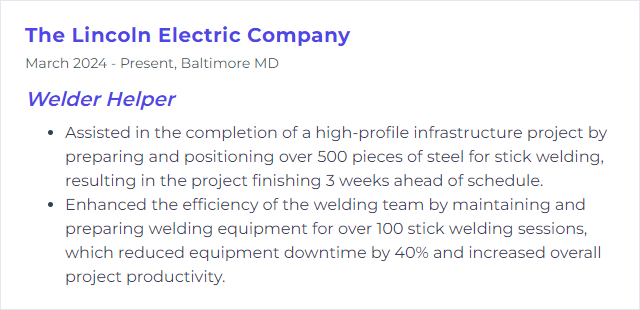
4. Flux Core
Flux cored arc welding (FCAW) uses a tubular wire filled with flux. It comes in two flavors: self-shielded (great outdoors, no external gas) and gas-shielded (higher deposition, cleaner, often in shops). It chews through thicker steel with speed.
Why It's Important
High travel speed, deep penetration, and strong performance in wind or on heavy sections make FCAW a productivity workhorse.
How to Improve Flux Core Skills
Clean the joint: Strip rust, paint, oil, and moisture to cut down on porosity.
Match settings to thickness: Tune voltage and wire feed for material and position. Verify with test beads.
Pick the right wire: Choose diameter and classification for base metal, position, and whether you’re self- or gas-shielded.
Mind stickout: Keep 3/8–1/2 inch wire extension for stable arc and proper penetration.
Drag technique: A slight pull angle usually produces better slag coverage and bead shape.
Maintain the gun: Clean contact tips, liners, and drive rolls. Smooth feeding prevents burnbacks and birdnesting.
Control the variables and FCAW rewards you with stout, efficient welds.
How to Display Flux Core Skills on Your Resume
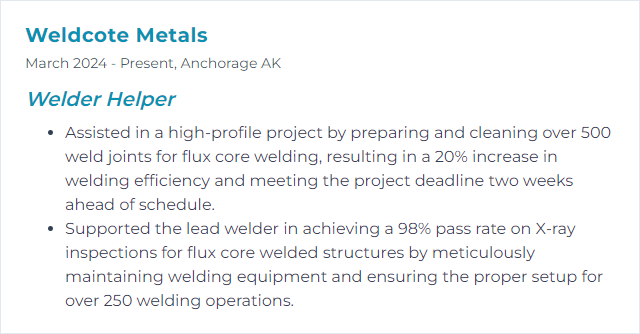
5. Plasma Cutting
Plasma cutting uses an electric arc to ionize gas and slice through conductive metals with speed and precision. Clean edges, tight radii, minimal prep afterward when dialed in.
Why It's Important
It makes fit-up faster. Templates, brackets, plate parts—cut accurately, weld sooner.
How to Improve Plasma Cutting Skills
Set it up right: Confirm connections, air quality and pressure, and consumables suited to material and thickness.
Use correct consumables: Nozzle, electrode, shield—all sized and matched. Replace at the first signs of wear.
Control your speed: Too fast leaves dross and angle; too slow widens kerf and overheats. Practice to find the sweet spot.
Hold consistent standoff: Use a drag shield or guide for repeatable distance and smoother cuts.
Maintain the system: Dry, clean air. Cables intact. Torch body free of debris.
Technique tweaks: Slight lead angle for direction changes. Pause gently at corners to complete the cut.
Safety: Eye, ear, hands, and good ventilation. Sparks fly far; clear the area.
Good prep plus steady motion equals crisp, repeatable cuts.
How to Display Plasma Cutting Skills on Your Resume
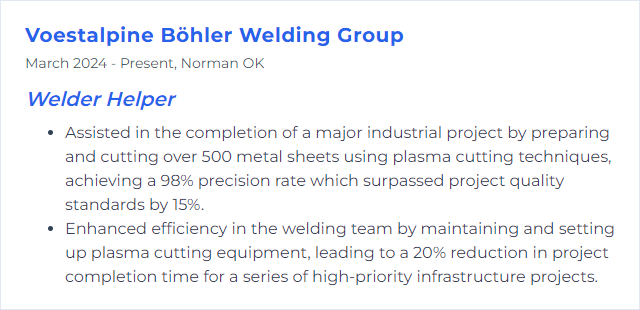
6. Oxy-Fuel Cutting
Oxy-fuel cutting heats steel to ignition temperature, then a stream of oxygen oxidizes and ejects metal to separate it. It’s most effective on carbon steels; stainless and aluminum generally require other methods.
Why It's Important
It’s portable, powerful, and great for thick plate, demolition, and rough shaping—essential in many fab and field setups.
How to Improve Oxy-Fuel Cutting Skills
Leak-free setup: Inspect hoses, regulators, and connections. Use flashback arrestors. Check for leaks before lighting.
Match tip and pressures: Select the right tip for thickness and set oxygen/fuel pressures per manufacturer data.
Correct preheat: Preheat to a bright cherry line, then press the oxygen lever to start the cut. Keep the kerf clean.
Travel speed: Move steadily to avoid heavy slag and beveling. Adjust on the fly based on the cut face.
Maintain gear: Keep tips clean, seats intact, and valves smooth. Replace worn parts before they cause trouble.
Respect the flame. Smooth hands, clean tips, stable pressures—your cuts will show it.
How to Display Oxy-Fuel Cutting Skills on Your Resume
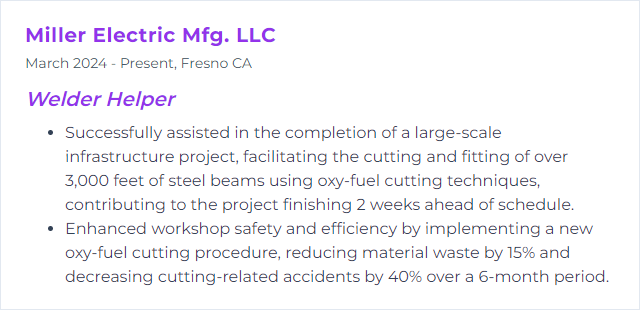
7. Blueprint Reading
Blueprint reading means translating technical drawings into action: weld symbols, dimensions, notes, materials, and sequence. You see the job before the first arc strikes.
Why It's Important
Accurate parts, correct joints, fewer mistakes. It keeps materials, time, and safety on track.
How to Improve Blueprint Reading Skills
Learn welding symbols: Understand fillets, grooves, finish marks, tail notes, and reference lines.
Master dimensions and tolerances: Read units, scales, datums, and allowable variation.
Study real prints: Compare drawings to finished parts and fit-ups. Close the loop between paper and product.
Take a course: Community colleges and trade programs offer welding-focused print reading. Practice-heavy classes help most.
Use visual aids: Diagrams, symbol charts, and sample parts speed up retention.
Repetition builds fluency. The drawings start talking back.
How to Display Blueprint Reading Skills on Your Resume
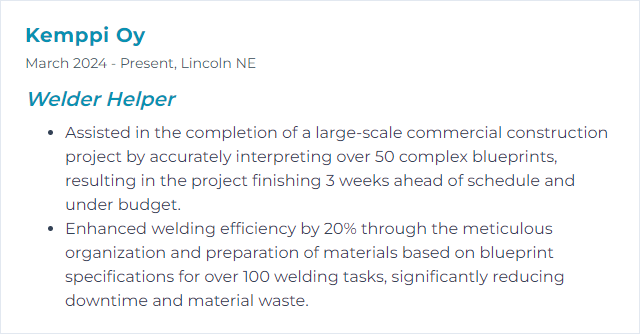
8. Grinding Techniques
Grinding shapes, cleans, and finishes metal using abrasive wheels or discs. It sets up joints, removes defects, and blends welds for strength and appearance.
Why It's Important
Good grinding makes welding easier and finishing faster. Bad grinding makes problems you have to weld around.
How to Improve Grinding Techniques Skills
PPE first: Eye and face protection, gloves, hearing protection, and FR clothing. Secure the work.
Pick the right wheel: Match abrasive type and grit to material and task (cutting, flap, wire, grinding).
Correct angle: Typically 15–30° for grinding; flatter for blending. Keep contact consistent.
Even pressure: Let the wheel cut. Excess pressure overheats and gouges.
Inspect tools: Check wheels for cracks, guards for alignment, cords for damage. Replace worn parts.
Practice on scrap: Learn how different wheels bite and how heat colors signal trouble.
Steady hands, cool metal, smooth results.
How to Display Grinding Techniques Skills on Your Resume
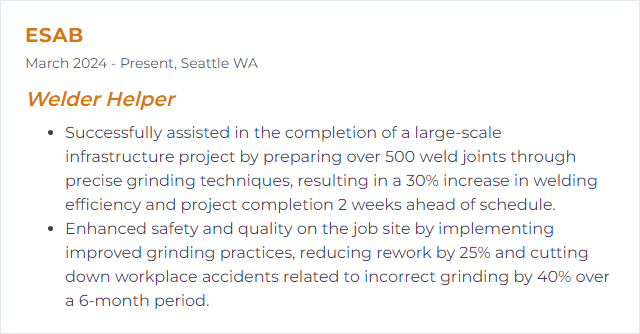
9. Safety Protocols
Safety protocols wrap around everything: PPE, lockout/tagout, ventilation, fire control, cylinder handling, electrical safety, and housekeeping. Habits that prevent injuries and downtime.
Why It's Important
Welding risks include burns, fumes, arc flash, fire, and electric shock. Protocols shrink those risks and protect everyone on the floor.
How to Improve Safety Protocols Skills
Comprehensive training: Mix classroom knowledge with hands-on drills—fire response, first aid, and equipment basics.
Routine audits: Check cables, guards, ventilation, and storage. Fix hazards fast.
PPE compliance: Helmets with correct shade, gloves, FR gear, proper footwear—every task, every time.
Ventilation and fume control: Use fume extraction and position work to move fumes away from breathing zones.
Emergency readiness: Clear evacuation routes, visible extinguishers, practiced response plans.
Maintenance culture: Scheduled checks on torches, leads, regulators, and machines to prevent failures.
Safety isn’t a poster. It’s daily discipline.
How to Display Safety Protocols Skills on Your Resume
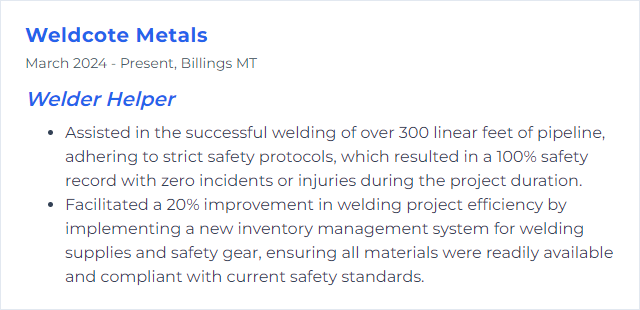
10. Metal Fabrication
Metal fabrication covers cutting, forming, and assembling parts into structures. Welding ties it together; accuracy and repeatability keep it standing.
Why It's Important
From brackets to buildings, fabrication turns drawings into the real thing. A Welder Helper who understands the flow—cut, fit, tack, weld, finish—keeps projects on pace and on spec.
How to Improve Metal Fabrication Skills
Build core process skills: Practice multiple welding processes, shearing, sawing, forming, and basic machining.
Know materials: Learn how carbon steel, stainless, and aluminum behave—heat input, expansion, warping, and distortion control.
Fixture and fit-up: Use squares, clamps, and jigs to hold tolerance before welding. Tack strategically.
Safety foundation: Cutting, grinding, and lifting each carry risks. Follow procedures and use the right tools.
Stay current: New consumables, machines, and shop practices emerge often. Keep learning.
Physical readiness: Strength, flexibility, and stamina matter for safe handling and clean work.
Precision up front saves hours on the back end.
How to Display Metal Fabrication Skills on Your Resume
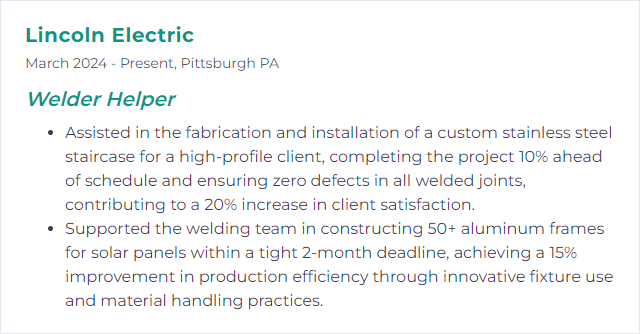
11. Pipe Fitting
Pipe fitting involves measuring, cutting, beveling, aligning, and securing pipe and fittings so welders can make sound joints that hold pressure and last.
Why It's Important
Leaks, misalignment, and stress fail fast. Good fit-up and support give the welder a fair fight and a pipeline a long life.
How to Improve Pipe Fitting Skills
Know your materials: Understand pipe schedules, alloys, and fittings. Different materials need different prep and procedures.
Measure twice: Accurate takeoffs, center-to-face math, and correct allowances for threads, gaskets, and bevels.
Cut and prep clean: Square cuts, correct bevel angles, and burr-free edges. Clean roots make clean welds.
Fit and align: Use levels, hi-lo gauges, and clamps. Control root gap and land consistently.
Support the work: Proper stands and restraints to prevent sagging and movement during tacking and welding.
Learn from pros: Watch how experienced pipefitters mark, roll, and tack. Small tricks make big differences.
Practice varied positions: 1G through 6G positions demand different approaches to gap, tacks, and heat.
Tight math and tidy prep lead to smooth weld-outs.
How to Display Pipe Fitting Skills on Your Resume
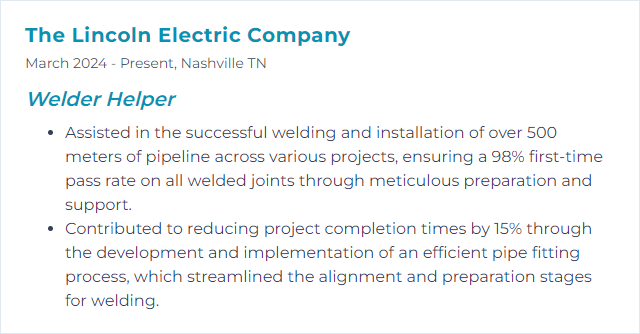
12. Quality Inspection
Quality inspection means verifying welds meet spec: dimensions, bead profile, fusion, and absence of defects. It spans visual checks and, when required, nondestructive testing methods like dye penetrant or magnetic particle testing.
Why It's Important
It protects safety, saves rework costs, and proves compliance. Strong records and sharp eyes prevent failures later.
How to Improve Quality Inspection Skills
Learn the standards: Study common welding symbols, procedure specs (WPS), and acceptance criteria for visual inspection.
Use the right tools: Fillet gauges, weld size gauges, straightedges, calipers, flashlights, mirrors—all calibrated and cared for.
Follow a checklist: Systematic steps reduce misses—prep, fit-up, root, fill, cap, and final dimensions.
Practice defect recognition: Porosity, undercut, overlap, lack of fusion, cracks—know how they look and why they happen.
Document clearly: Photos, measurements, and notes that others can follow. Traceability matters.
Seek feedback: Review findings with experienced inspectors and welders; adjust your eye and methods.
Consistent methods, calibrated tools, and calm attention to detail—quality shows up everywhere.
How to Display Quality Inspection Skills on Your Resume

